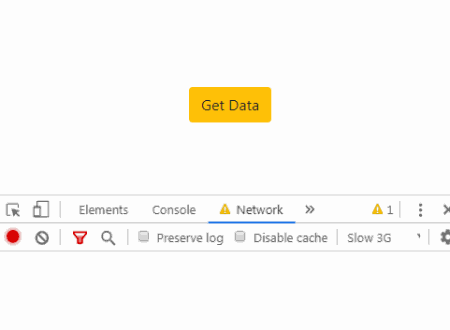In this tutorial, we will implement a global Spinner Loader in the Angular project by using a third-party package. The Spinner loader is shown whenever there is a pending HTTP call using Interceptors. This spinner loader comes with many configuration settings to customize its look and feel in your project.
Angular interceptors were introduced after version 4.3, which are used to handle HTTP call behaviour to the next level. This Loader Spinner also creates an interceptor to show or hide the spinner loader automatically, but we can also control it to show/ hide manually for specific situations.
Let’s get started!
How to Add Global HTTP Loader Spinner in Angular App?
Step 1 – Create a new Angular project
Step 2 – Install and Configure ng-http-loader
Step 4 – Update App Module
Step 5 – Add Spinner Loader
Step 6 – Test the Spinner Loader
Step 7 – Options for Spinner Loader
Step 8 – Styling the Spinner
Step 9 – Custom Template for Loader
Step 1 – Create a new Angular project
Run the following command to create a new project or you can skip this step to continue with your existing project.
$ ng new angular-http-spinner-loader
? Would you like to add Angular routing? No
? Which stylesheet format would you like to use? CSSStep 2 – Install and Configure ng-http-loader
Run the following command to install ng-http-loader in the project:
$ npm i ng-http-loader
Step 3 – Update App Module
After successfully installing the package, we need to open app.module.ts file to import it and add in the imports array as shown below:
// app.module.ts
import { BrowserModule } from '@angular/platform-browser';
import { NgModule } from '@angular/core';
import { AppRoutingModule } from './app-routing.module';
import { AppComponent } from './app.component';
import { HttpClientModule } from '@angular/common/http';
import { NgHttpLoaderModule } from 'ng-http-loader';
@NgModule({
declarations: [
AppComponent
],
imports: [
BrowserModule,
AppRoutingModule,
HttpClientModule,
NgHttpLoaderModule.forRoot(),
],
providers: [],
bootstrap: [AppComponent]
})
export class AppModule { }
Here we also added HttpClientModule to make HTTP calls in the project.
Step 4 – Add Spinner Loader
Now you simply need to add the following template in project root which can be app.component.html:
<ng-http-loader></ng-http-loader>Step 5 – Test the Spinner Loader
To test this loader, we added an HTTP call method to load Moves list from IMDB server:
Add the following code in the app.component.ts file:
// app.component.ts
import { Component } from '@angular/core';
import { HttpClient } from '@angular/common/http';
@Component({
selector: 'app-root',
templateUrl: './app.component.html',
styleUrls: ['./app.component.css']
})
export class AppComponent {
title = 'angular-http-spinner-loader';
constructor(private http: HttpClient) {}
getIMDBData() {
return this.http
.get<any>('http://www.omdbapi.com/?apikey=YOUR_OMDB_KEY&s=car')
.subscribe((response) => {
console.log(response);
}, (error) => {
alert('Error Found!');
});
}
}Here we are making a get HTTP call to test our spinner.
You can get your free key here
In app.component.html there is a button and loader component:
<div class="container text-center" style="margin-top:100px;">
<button type="button" class="btn btn-warning" (click)="getIMDBData()">Get Data</button>
</div>
<ng-http-loader></ng-http-loader>This loader will show a spinner and a backdrop shadow on the full screen, we can customize its properties.
Step 6 – Options for Spinner Loader
The following properties of the NgHttpLoader component can be customized to change spinner style and behavior:
<strong>[backdrop]</strong>: Takes boolean to show/ hide backdrop shadow; default is true.
[backgroundColor]: Color of the spinner.
<strong>[debounceDelay]</strong>: After how much milliseconds the spinner will show.
<strong>[extraDuration]</strong>: Time in milliseconds to show spinner after completing Http call.
<strong>[minDuration]</strong>: Minimum duration for which spinner will show at least.
<strong>[opacity]</strong>: Opacity of the spinner.
<strong>[spinner]</strong>: Different styles of the spinner can be added.
<ng-http-loader
[backdrop]="false"
[backgroundColor]="'#ff0000'"
[debounceDelay]="100"
[extraDuration]="300"
[minDuration]="300"
[opacity]=".6"
[spinner]="spinkit.skWave">
</ng-http-loader>Step 7 – Styling the Spinner
Spinner style can be changed by importing Spinkit class in component as shown below:
// app.component.ts
import { Component } from '@angular/core';
import { HttpClient } from '@angular/common/http';
import { Spinkit } from 'ng-http-loader';
@Component({
selector: 'app-root',
templateUrl: './app.component.html',
styleUrls: ['./app.component.css']
})
export class AppComponent {
title = 'angular-http-spinner-loader';
spinnerStyle = Spinkit;
....
....In the template, we can change style using [spinner] property:
<ng-http-loader
[backdrop]="false"
[backgroundColor]="'#ff0000'"
[debounceDelay]="100"
[extraDuration]="300"
[minDuration]="300"
[opacity]=".6"
[spinner]="spinnerStyle.skWanderingCubes"
>
</ng-http-loader>Different style are skChasingDots, skCubeGrid, skDoubleBounce, skRotatingPlane, skSpinnerPulse, skThreeBounce, skWanderingCubes and skWave
Step 8 – Custom Template for Loader
You can also use your custom template for the spinner loader by following the below steps:
- Create your component
- Add it to the
entryComponentsarray in your module’s configuration - Reference your component as a public property in your
app.component.ts - Reference the predefined property in the ng-http-loader component selector like this:
<<span class="pl-ent">ng-http-loader</span> [entryComponent]=<span class="pl-s"><span class="pl-pds">"</span>myAwesomeComponent<span class="pl-pds">"</span></span>></<span class="pl-ent">ng-http-loader</span>>
Conclusion
That’s it using this package you can easily add a Spinner loader quicky in your project. This is useful when you don’t want a user to click anywhere till the current HTTP call is in progress as there is a backdrop that prevents any accidental clicks.


Leave a Reply